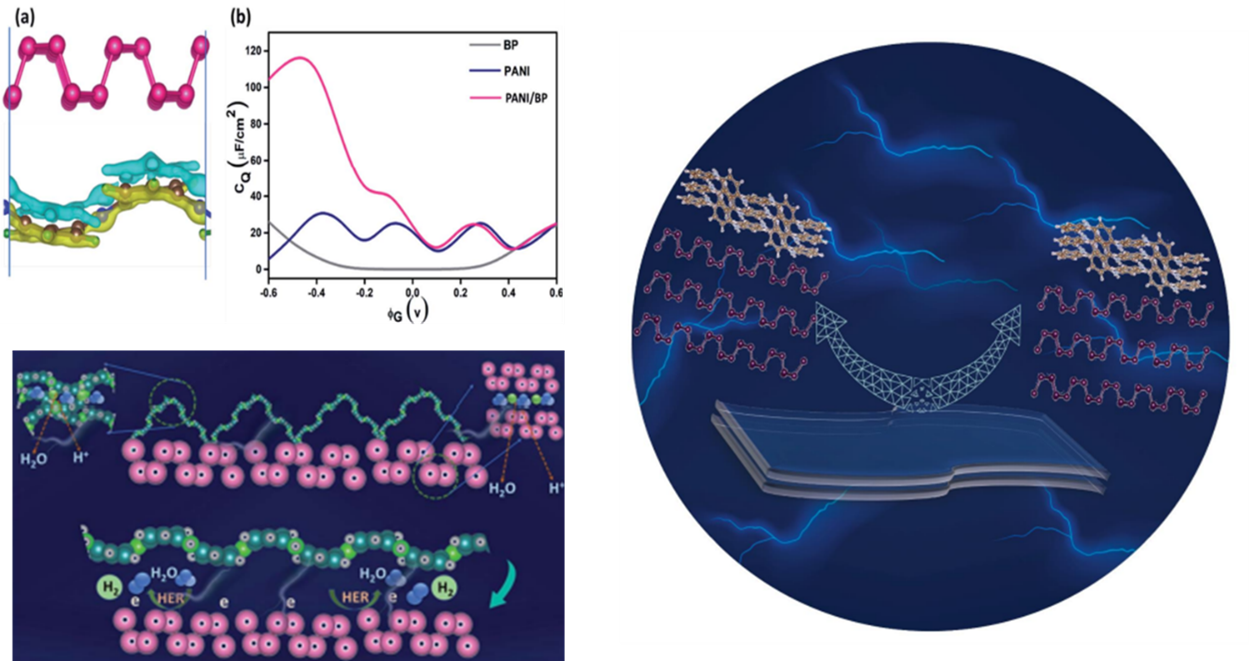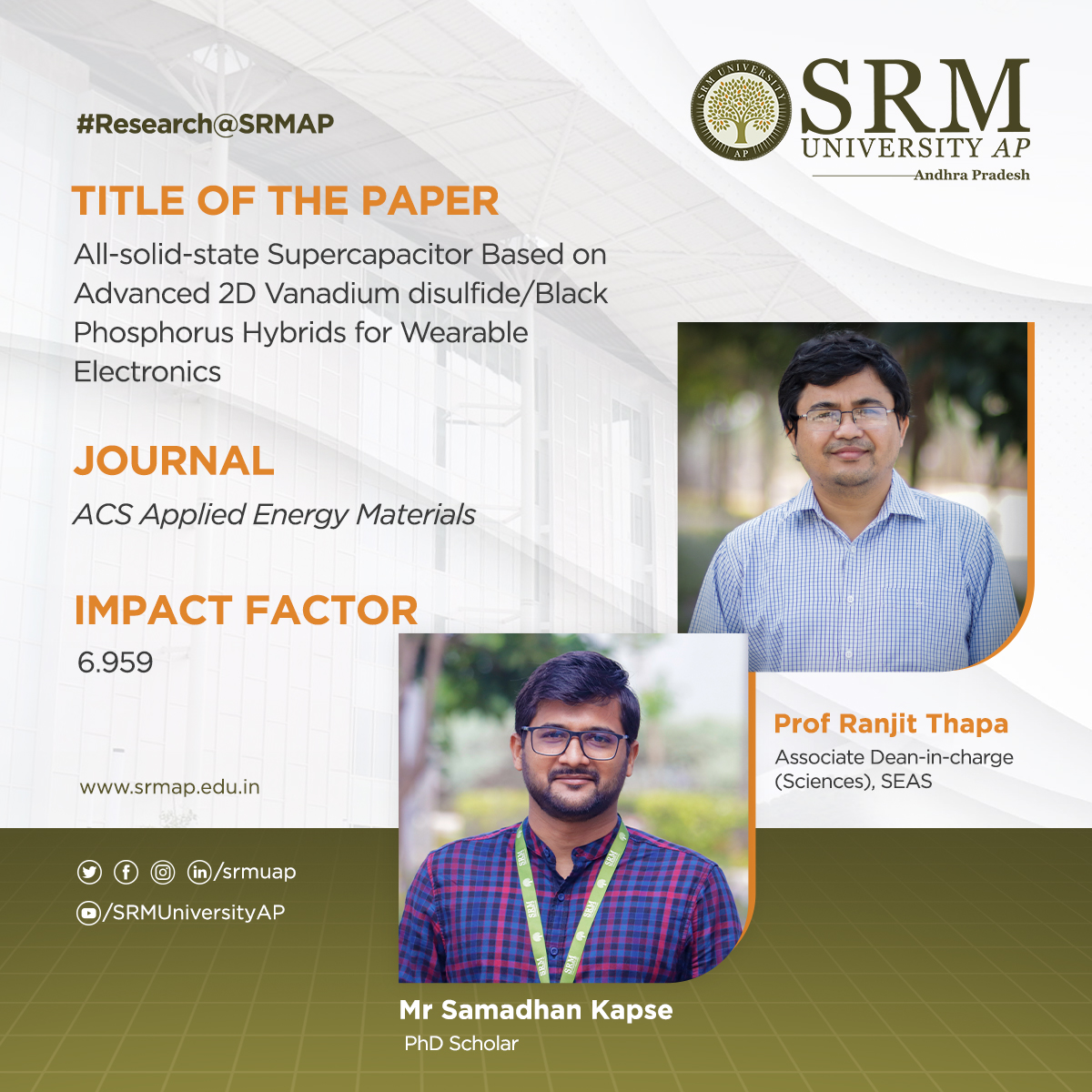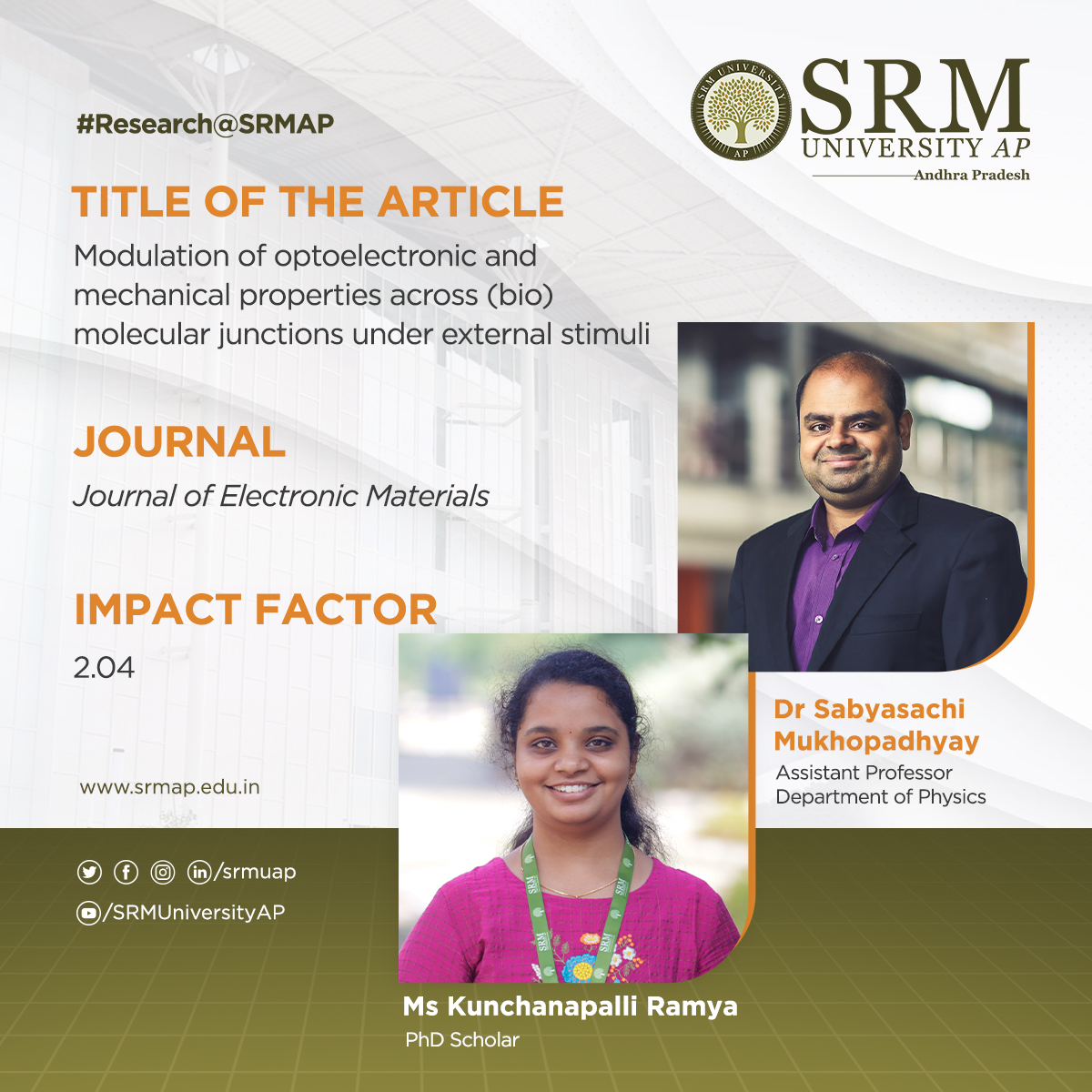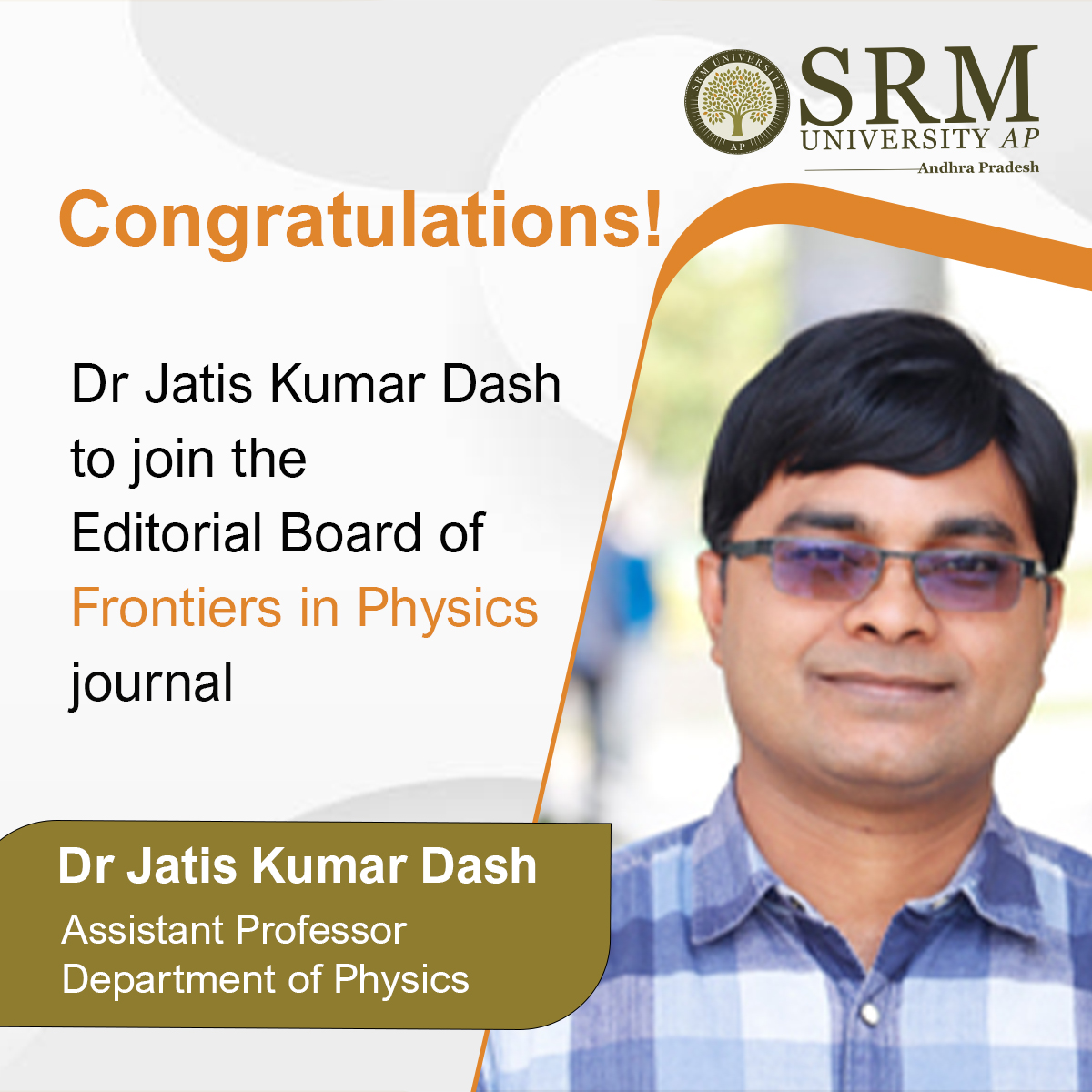Recent News
- Large-scale production of BP nanosheets September 1, 2022
 Research at the Department of Physics has effectively produced and characterised BP nanosheets on a large scale by a simple solvothermal approach, and the formation mechanisms are discussed. The paper, 2D-Black Phosphorus/Polyaniline Hybrids for Efficient Supercapacitor and Hydrogen Evolution Reaction Applications Check for updates, has been published by Prof Ranjit Thapa, Associate Dean of Sciences, as a corresponding author, and his PhD student, Mr Samadhan Kapse in Sustainable Energy & Fuels having an Impact Factor of 6.367.
Research at the Department of Physics has effectively produced and characterised BP nanosheets on a large scale by a simple solvothermal approach, and the formation mechanisms are discussed. The paper, 2D-Black Phosphorus/Polyaniline Hybrids for Efficient Supercapacitor and Hydrogen Evolution Reaction Applications Check for updates, has been published by Prof Ranjit Thapa, Associate Dean of Sciences, as a corresponding author, and his PhD student, Mr Samadhan Kapse in Sustainable Energy & Fuels having an Impact Factor of 6.367.Abstract
Black phosphorous (BP) is an emerging 2D material with exciting physicochemical properties with broad applicability in electronics. Stability in the ambient environment, large-scale synthesis, and volume expansion during the charge/discharge process hinder its application in energy storage. Here, we report a facile gram-scale synthesis of BP in a mild reaction condition by a simple and cost-effective wet chemical method. To overcome its degradation and sluggish electrochemical performance, an organic hybrid with polyaniline is also prepared. Further, we fabricated a flexible supercapacitor device which results in an exceptional specific capacitance of 969 mFcm-2 at a current density of 0.4 Acm-2, which displayed a high energy density of 21.5 mWhkg-1 at a power density of 231 mWkg-1 with good cycling stability of 91% after 4000 charge-discharge cycles. Similarly, the cyclic voltammetry studies of the flexible devices at various bending angles display a similar CV profile for all the bending angles, which confirms the device’s reliability for flexible applications.
Explanation of the research
BP-PANI hybrid materials were prepared by the in-situ chemical oxidation method. By this approach, the researchers got highly stable BP by an inorganic-organic linkage, and its energy storage performance was also investigated. The fabricated symmetric flexible supercapacitor device based on BP/PANI heterostructure exhibited an extraordinary specific capacitance of 969 mFcm-2 at a current density of 0.4 Acm-2. Moreover, the fabricated device showed a high energy density of 21.5 mWhkg-1 and a power density of 231 mWkg-1 with impressive cycle stability of 91% after 4000 charge-discharge cycles. This study paves the way for future research into gram-scale BP synthesis, stability via an inorganic-organic coupling, and its potential application in electrochemical energy storage devices.
Social implications of the research
With the rapid growth of portable/flexible electronics and the high demand for clean energy, supercapacitors have sparked interest due to their advantages of fast charge/discharge rates, long cycle life, and high-power density compared to conventional energy-storage devices such as dielectric capacitors and Li-ion batteries. Likewise, developing new functional materials with outstanding properties could shed light on many issues, including pollution, energy, synthesis, and cost. In recent years few graphene analogues materials have been explored, and because of their tuneable physicochemical properties, they were used in energy storage applications. Generally, black phosphorus was synthesised from polymorphs of phosphorus under vigorous reaction conditions. However, these high temperature/pressure conditions suffer from safety, toxicity, controllability, and gram-scale production.
Quantum capacitance is an efficient tool for rapidly screening materials for supercapacitor applications and therefore is the future of this research. The researchers have collaborated with Mr Namsheer K, Mr Mridula Manoj, Mr Aditya Sharma, and Dr Chandra Sekhar Rout from the Functional Materials & Devices Laboratory, Centre for Nano Material Sciences, Jain University, Bangalore, India, in this work.
Continue reading → - Efficient and selective single-atom catalysts for eNRR September 1, 2022

The Department of Physics is glad to announce that Dr Ranjit Thapa and his PhD scholar Mr Samadhan Kapse have published their research paper “Descriptors and graphical construction for in silico design of efficient and selective single-atom catalysts for eNRR” in the journal Chemical Science, having an Impact Factor of 9.969. The paper was published in collaboration with Prof Shobhana Narasimhan, Theoretical Sciences Unit and School of Advanced Materials, Jawaharlal Nehru Centre for Advanced Scientific Research, Bangalore. Chemical Science is a highly prestigious nature Index journal, which accepts only breakthrough research contributions for publication.
The Haber-Bosch process for ammonia synthesis has been described as possibly the most important scientific discovery of the twentieth century. However, it requires high temperatures and pressures and results in large energy consumption and emission of greenhouse gases. That is where electrochemical nitrogen reduction reaction (eNRR) comes into the picture. It synthesizes ammonia from nitrogen and water under mild conditions (N2 + 6H+ + 6e- → 2NH3). However, currently available eNRR catalysts need improvement in three respects: (i) the efficiency of nitrogen fixation needs to be increased, (ii) the competing hydrogen evolution reaction (HER) needs to be suppressed, and (iii) hydrogen poisoning of active sites must be avoided. Transition metals are popular eNRR catalysts; however, they tend to favour hydrogen adsorption due to the formation of strong metal d – hydrogen σ bonds, and tend to have a low affinity for N2 adsorption. Their research mitigates these problems by appropriately tuning the electronic structure by altering the environment surrounding metal atoms at the active site of single-atom catalysts (SACs). Moreover, in previous works, typically, only one criterion (usually competing HER) was used to optimize catalyst function, whereas they simultaneously optimised the catalyst function with respect to multiple criteria.

They have screened 66 different transition metal-based SACs for possible use in eNRR. To determine the best possible catalyst, they considered three factors: N2 adsorption, hydrogen poisoning and the overpotential of eNRR. Here, the valence electron occupancy (Oval) is identified as a new electronic descriptor that can predict the overpotential value. They emphasised that having a low η_NRR alone does not suffice to indicate a suitable eNRR catalyst, since if the adsorption free energy is higher for H than N2, active sites will be poisoned, hindering eNRR. Thus, they present a simple graphical procedure for identifying the most promising catalysts. To carry out this procedure, one must compute only 〖ΔG〗_(H^* ) and 〖ΔG〗_(NNH^* ), the changes in the free energies of H and NNH adsorption, respectively (note that η_NRR can be deduced if 〖ΔG〗_(NNH^* ) is known). The most promising candidate is identified as Sc-Pc, which they predict will have no H poisoning and will be highly selective for eNRR over HER. Moreover, they predict that Mn-Pc, Cr-N4, Fe-N2C2 should also be highly efficient, with low overpotential (η_NRR < 1 V) toward eNRR, and no H poisoning. In future they aim to find the selective materials for catalytic reactions by studying the origin of activity, reaction mechanism, etc.
Abstract of the Research
The electrochemical nitrogen reduction reaction (eNRR) offers the possibility of ammonia synthesis under mild conditions; however, it suffers from low yields, a competing hydrogen evolution reaction pathway, and hydrogen poisoning. We present a systematic approach toward screening single atom catalysts (SACs) for eNRR, by focusing on key parameters computed from density functional theory, and relationships between them. We illustrate this by application to 66 model catalysts of the types, TM-Pc, TM-NXCY, and TM-N3, where TM is a 3d transition metal or molybdenum. We identified the best SACs as Sc-Pc, Cr-N4, Mn-Pc, and Fe-N2C2; these show eNRR selectivity over HER and no hydrogen poisoning. The catalysts are identified through multi-parameter optimization which includes the condition of hydrogen poisoning. We propose a new electronic descriptor Oval, the valence electron occupancy of the metal center, that exhibits a volcano-type relationship with eNRR overpotential. Our multi-parameter optimization approach can be mapped onto a simple graphical construction to find the best catalyst for eNRR over HER and hydrogen poisoning.
- VS2-BP hybrid electrode material for supercapacitor applications August 24, 2022
 A theoretical investigation is highly important to investigate the properties of materials, the origin of selectivity, and the effect of various parameters in designing promising electrode materials for supercapacitor applications. The latest research paper by Mr Samadhan Kapse, PhD Student in the Department of Physics, and Prof Ranjit Thapa, Associate Dean of SEAMS (Sciences), envisions this and developed a novel VS2-BP hybrid electrode material. Their article titled All-solid-state Supercapacitor Based on Advanced 2D Vanadium disulfide/Black Phosphorus Hybrids for Wearable Electronics has been published in the journal ACS Applied Energy Materials with an impact factor of 6.959.
A theoretical investigation is highly important to investigate the properties of materials, the origin of selectivity, and the effect of various parameters in designing promising electrode materials for supercapacitor applications. The latest research paper by Mr Samadhan Kapse, PhD Student in the Department of Physics, and Prof Ranjit Thapa, Associate Dean of SEAMS (Sciences), envisions this and developed a novel VS2-BP hybrid electrode material. Their article titled All-solid-state Supercapacitor Based on Advanced 2D Vanadium disulfide/Black Phosphorus Hybrids for Wearable Electronics has been published in the journal ACS Applied Energy Materials with an impact factor of 6.959.Abstract
Vanadium disulfide-Black Phosphorus (VS2-BP) hybrids were synthesised by a one-pot hydrothermal assisted method to achieve enhanced electrochemical activity for supercapacitor applications. The concentration of BP was optimised to prevent the restacking nature of VS2 and to enrich the active edges for electrolytic ion intercalation. The charge storage kinetics of the best-performing VS2-BP as an active electrode has demonstrated the dominance of the pseudocapacitive nature of the material. Further, by sandwiching with PVA/K2SO4 gel electrolyte, an all-solid-state (ASS) Vanadium disulfide/Black Phosphorus-50 mg (VS2-BP-50) symmetric device was developed on highly conductive carbon paper. The ASS VS2-BP-50 symmetric device displays the highest specific areal capacitance of 203.25 mF/cm2. It exhibits the maximum areal energy density of 28.22 µW h cm-2 at an areal power density of 596.09 mW cm-2, outperforming previous literature. We used density functional theory to understand the origin of high quantum capacitance. We found that the charge accumulation region between VS2 and BP monolayers and the charge transfer is the origin of the improved density of states in the VS2-BP hybrid. Also, we observed the higher mobility of K+ ion and a higher diffusion rate using the Density functional theory (DFT) method.
Explanation of the research
A novel VS2-BP hybrid electrode material was prepared using a simple hydrothermal approach. Due to a synergistic effect, it was discovered that adding BP to metallic VS2 enhances the number of electrochemically active sites, resulting in increased surface activity. It also accelerates reaction kinetics with electrolyte ions by improving the electrical behaviour of active electrode material. As a result, the hybrid technique overcomes the weaknesses of individual components during electrochemical processes, resulting in increased performance that has been limited by individuals. The BP nanosheets behaved as a pore region for electron transport and prevented the VS2 layers from re-stacking. Systematic experiments are conducted by selecting the ideal precursor ratios to generate a high-quality VS2-BP hybrid with enhanced electronic conductivity. Furthermore, in the overall collective charge storage of the VS2-BP-50 hybrid material, the present results demonstrated that capacitive contributions outnumber diffusive contributions. The ASS VS2-BP-50 symmetric supercapacitor device was also designed to have a high areal capacitance of 203.25 mF/cm2 with a maximum areal power density of 596.09 mW cm-2. The extraordinary performance of the ASS VS2-BP-50 symmetric device illustrates its versatility in terms of designing a high-power density ASS supercapacitor for flexible and wearable device applications. The work functions of BP, VS2, and VS2-BP are 0.73 eV, 5.37 eV, and 4.99 eV, respectively, which help in the charge transfer mechanism and increase the density of state at the Fermi level, and subsequently, the quantum capacitance of the heterostructure.
Collaborations
1. Mr Aditya Sharma, Centre for Nano and Material Sciences, Jain Global Campus, Jakkasandra, Ramanagaram, Bangalore – 562112, Karnataka, India
2. Mr Ankur, Centre for Nano and Material Sciences, Jain Global Campus, Jakkasandra, Ramanagaram, Bangalore – 562112, Karnataka, India
3. Mr Sagar Bisoyi, Department of Physics, School of Applied Sciences, KIIT Deemed to be University, Bhubaneswar-751024, Odisha, India.
4. Dr Gopal K. Pradhan, Department of Physics, School of Applied Sciences, KIIT Deemed to be University, Bhubaneswar-751024, Odisha, India.
5. Dr Chandra Sekhar Rout, Centre for Nano and Material Sciences, Jain Global Campus, Jakkasandra, Ramanagaram, Bangalore – 562112, Karnataka, India
Social implications of the research
With the exponential development of portable/flexible electronics and the high demand for renewable energy, conventional energy-storage devices, such as supercapacitors, have attracted attention due to their benefits of fast charge/discharge rates, long cycle life, and high-power density. Similarly, developing novel functional materials with exceptional qualities could shed light on a plethora of challenges, including environmental pollution, energy crisis, etc. Two-dimensional (2D) layered materials, such as metallic 1T MoS2 single layers, SnSe2, MXenes, and black phosphorous (BP), have been intensively studied for supercapacitor applications. These materials benefit from efficient ion intercalation and electrosorption. The two-dimensional (2D) layered transition-metal dichalcogenides (TMDs) have recently piqued the scientific community’s curiosity.
- Exploring the charge transport across protein-based molecular junctions August 2, 2022
 The latest research at the Department of Physics is investigating the charge transport across protein-based molecular junctions. Researchers envision fabricating bio- FETs which is useful in electronic devices as an alternative to Si- technology. Assistant Professor Dr Sabyasachi Mukhopadhyay and his PhD scholar Kunchanapalli Ramya published their paper Modulation of optoelectronic and mechanical properties across (bio) molecular junctions under external stimuli in the journal of Electronic Materials with an impact factor 2.04.
The latest research at the Department of Physics is investigating the charge transport across protein-based molecular junctions. Researchers envision fabricating bio- FETs which is useful in electronic devices as an alternative to Si- technology. Assistant Professor Dr Sabyasachi Mukhopadhyay and his PhD scholar Kunchanapalli Ramya published their paper Modulation of optoelectronic and mechanical properties across (bio) molecular junctions under external stimuli in the journal of Electronic Materials with an impact factor 2.04.Abstract
Molecular junctions are formed by wedging molecules between two metal electrodes. Besides the conventional parameters of the metal-molecule-metal junction, such as the work function of electrodes and the molecules’ energy gap, molecule-electrode electronic coupling strength also plays a vital role in modulating the electronic properties of the molecular junction under external stimuli. We have also calculated several transport parameters which play a crucial role in finding the origin of conductance modulation under the external stimuli. We could find that before particular humidity conditions, the modulation in the conductance is due to the variation in coupling strength, which is due to the modulation in the electrostatic environment of retinal chromophores of protein by changing the structure of protein under various external stimuli.
Researchers have explored the external stimuli (illumination, force, and humidity conditions) effect on charge transport across bacteriorhodopsin-based molecular junctions. Their future research plans include bio- FET fabrication with the protein reported and studying the transistor characteristics across it.
Continue reading → - Dr Jatis Kumar Dash to join the Editorial Board of Frontiers in Physics journal August 1, 2022
 Frontiers in Physics is a peer-reviewed scientific journal. It covers the entire field of Physics ranging from experimental to computational and theoretical physics. Assistant Professor Dr Jatis Kumar Dash from the Department of Physics has been invited to be a part of the Editorial Board of this prestigious journal. The multidisciplinary journal focuses on applied physics and has an impact factor of 3.560.
Frontiers in Physics is a peer-reviewed scientific journal. It covers the entire field of Physics ranging from experimental to computational and theoretical physics. Assistant Professor Dr Jatis Kumar Dash from the Department of Physics has been invited to be a part of the Editorial Board of this prestigious journal. The multidisciplinary journal focuses on applied physics and has an impact factor of 3.560.Dr Jatis Kumar Dash feels honoured to receive the invitation to join the Editorial Board. He finds it satisfying to get involved in scrutinising and reviewing manuscripts that concentrate on materials, experimental and condensed matter of Physics, and related devices. The process of reviewing these manuscripts enriches his knowledge in the subject domain. This helps him widen his research horison and explore novel ideas. The tenure of his role as an editor is not defined but is expected to last for five years.
Continue reading →

